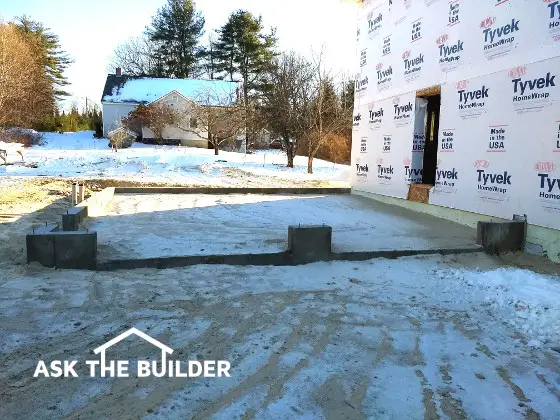Advice For Architects-To-Be And You Too

Can you see the mistake made by the architect in this photo? Look at the short stub foundation wall on the right then the height of the doorway from the garage to the house. (C) Copyright 2017 Tim Carter
Advice For Architects-To-Be And You Too!
Not only do I answer questions each day at my own AsktheBuilder.com website, but I also do the same at another major question site. Two days before Christmas, I answered a most unusual question.
The gentleman wanted to know the best books I’d recommend about building and construction for young architecture students. You might think my first reaction would be to provide a few links from Amazon.com to one or two top books.
I didn’t do that. Instead I uploaded a photo (see above) I had taken the day before of a house being built near me and a short story. I drive by this house each time I go into town. About a week before Christmas, the builder had completed pouring the foundation for a two-car attached garage. There are two separate garage doors in this structure.
As often happens, I did it at the last home I built for my family, the garage foundation is poured at a later date than the house foundation. Doing this allows better access to the house foundation forms for ready-mix concrete trucks. If you decided to pour both foundations at once, you might have to incur the cost of an expensive concrete pump truck.
I decided to take a few photos of the garage and once I pulled into the driveway I shook my head in disbelief. The two-car garage had a fatal flaw.
You need to know that the first floor level of the house is going to be about 2 feet higher than the garage floor. This means there has to be a minimum 3-foot by 3-foot platform that projects into the garage immediately adjacent to the door leading from the garage into the house. Two steps will get you from the platform down to the garage floor.
The edge of the garage door that’s closest to the house is about 28 inches from the sidewall of the house. The platform is going to occupy space that was supposed to be for the car. Now it’s only good for a touring Harley Davidson motorcycle or a golf cart.
My answer to the man asking about the books was that instead of reading about how to build, the young architects-to-be should just go work full-time on construction sites for a minimum of a year. Two years would be a much better investment of time. This hand-on construction experience would pay off in spades later in their career allowing them to better serve their clients.
I went on to mention how the young women and men should work for both remodeling and new construction builders. They’ll quickly discover the challenges faced by builders when trying to work from plans that contain flaws or oversights.
I had a similar mistake happen to me late in my building career. I was on the most challenging job I had ever bid on. The architect was seasoned and we were good friends. He had developed a niche of doing very interesting giant room additions and complex remodel jobs.
This job had me adding a small house onto a house for all intents and purposes. The existing attached garage on the home was to become the new giant kitchen. A new garage with two separate garage doors was going to be in the new structure.
The new structure was brick veneer and the plans called for gorgeous arched openings over the doors. I built the forms for the bricklayer and placed them exactly where the architect said to put them. I trusted the architect had done everything right.
The architect made a mistake and had the arches too low. When you tried to pull in the homeowner’s minivan into the garage, the roof of the van would hit the brick. Had a young architect-to-be been working with me the day we tore out the brick to redo it, I guarantee you she/he would never ever make that mistake in their career.
The young people would also see how frustrating it is to work from plans lacking great details of complex connections, blueprints missing interior elevations, and AWOL room finish schedules along with minimal written specifications.
All of these things lead to misunderstandings, drama, blown budgets and in the worst cases expensive lawsuits where only the attorneys win. If you know a person that expresses an interest in being an architect, please convince them to go get muddy, sweaty and dusty for two years. They’ll forever thank you!
Column 1229
One Response to Advice For Architects-To-Be And You Too